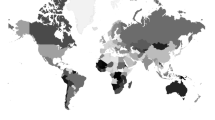Abstract
Have the government policy of resource-rich economies in managing wealth succeeded in diversifying these economies and, in doing so, prevented them from being trapped by a Dutch Disease? Contributed to this symposium papers examine these issues in the settings of Russia, Azerbaijan, Kazakhstan and several other Central Asian countries. They assess SWFs' rules and performance by comparing them against best practice, review government policies in channeling wealth towards other (non) oil (or other natural resource) sectors via financial institutions and evaluate those funds' stabilizing and systemic roles during recent financial crisis.
Similar content being viewed by others
Avoid common mistakes on your manuscript.
This Symposium discusses issues that are very relevant for many transition economies, economies issues with respect to natural resource management. Intergenerational wealth maximization implies transforming oil or other natural resource revenues into financial wealth. This optimal consumption path follows from the Permanent Income Hypothesis of Milton Friedman. The conventional view with respect to optimal resource revenue management is that the government should maintain a stable level of spending out of natural resource wealth (Wierts and Schotten, 2008). Establishment of a special institution to pursue this goal (i.e. a sovereign wealth fund) is usually seen as a prudent approach. By examining a range of aspects of natural resource management in resource-rich economies of the formerly centrally planned economies the papers presented in this symposium jointly reveal interactions between resource management, policy choice and economic and institutional performance in these economies.
The first paper of the Symposium by Richard Pomfret makes an assessment of resource boom revenue management by studying four Central Asian countries, Kazakhstan, Kyrgyzstan, Uzbekistan and Turkmenistan and Azerbaijan and Mongolia. The paper specifically focuses on (a) methods of involving foreign partners in resource exploitation, and (b) use of Sovereign Wealth Funds to manage the windfall coming from those resources. What is interesting about this paper is that the author takes a broad scope of countries covering the whole region, including those with and those without a formal institution that manages natural resource revenues. The author shows that all these countries have made different policy choices in managing natural resource revenues. While each of these experiences is being unique, they could be grouped into two contrasting groups, namely those open to FDI, Kazakhstan, Kyrgyzstan and Azerbaijan, versus those closed to FDI, Turkmenistan, Uzbekistan and Mongolia. While natural resource management in open economies is associated with rather generous profits generated by foreign firms, corruption allegations and other adverse effects, closed economies retained full control over resource exploitation but have missed opportunities from involving foreign partners. The major causes of shortcomings, as the author argues, are weak institutions and macro-policy inexperience of these transition countries and, as a consequence, a lack of a continuous and clear policy towards natural resource management. Production Sharing Agreements (PSAs) between the state and a foreign company examined in the paper are one example of the finding that, although institutions matter for the long-term prosperity of resource-rich countries, the relationships are more complex than revealed by indicators of institutional quality or of ownership patterns.
The second paper of the Symposium, by Matthias Luecke, continues discussion by focusing on resource-rich economies with an institution dedicated to resource revenue management and analyses the mission and performance of SWFs of Azerbaijan and Kazakhstan against the benchmark, the SWF of Norway. The paper gives a thorough assessment of these funds’ performance from both economic stabilization and saving perspectives. Thus, it shows that the net effect of the arrangements in Kazakhstan and Azerbaijan has probably been to strengthen presidential control over the spending of oil-related revenues, over and above the influence that the presidents wield over the budget process in any case. The author argues that shifting control over resource rents from parliaments to possibly less myopic presidents comes at the price of a muddled fiscal relationship between the funds and the government budgets. The arrangement in Kazakhstan is also marked by the absence of a genuine stabilization mechanism for fluctuations in the non-oil deficit. At the same time, the paper finds that the use of oil revenues in Azerbaijan and Kazakhstan has been broadly prudent so far, as shown by the build-up of oil fund assets in both countries. The institutional framework of the funds (an extra-budgetary fund in Azerbaijan (The State Oil Fund of Azerbaijan (SOFAZ)) and a separate government account with the central bank in Kazakhstan (The National Fund of the Republic of Kazakhstan (NRFK)) generates an enhanced visibility and constitutes a good starting point for efforts to make fiscal operations, and the use of resource revenues in particular, more transparent. SOFAZ in particular demonstrates a remarkable transparency of its operations, the issue that has been of concern in many other resource-rich economies (Truman, 2007). The paper concludes that once such an agent (SWF) is set, it would be easier for the public to scrutinize its operations, which would eventually limit discretionary control of revenues and allow for sustainable governance of these resources.
The paper by Kalyuzhnova and Nygaard extends analysis of SWFs further by evaluating channeling of (oil) resource revenues to non-oil sectors via SWFs in Russia and Kazakhstan, namely Vnesheconombank and Samruk-Kazyna, respectively. It contains a thorough analysis of the crisis management and system preserving roles of SWFs in both countries during the financial crisis of 2008–2009. The paper further distinguishes between crisis management and systemic role of these special vehicles. Although these SWFs were constructive in terms of system preservation and economic stabilization, the paper is concerned that there are structural weaknesses that yet to be addressed. Furthermore, the authors’ analysis shows that these institutions in fact serve as instruments for pursuing national economic principles. As a result of such state interventions, argue the authors, achieving allocative efficiency as well as genuine diversification of the economy is questioned. Thus, conclude the authors, rapid credit expansion in recent years has not concomitantly led to a comparable expansion of investments. This issue is compounded by structural weaknesses in the banking and credit system that, partially, necessitates the development of the dedicated state owned investment vehicles discussed in this paper.
All papers presented in this Symposium are part of an emerging literature on the growth and performance of SWFs and associated concerns. Each of the three papers contributes to this debate and presents policy implications for natural resource management in emerging markets. Further, it would be interesting to study SWFs, operations in these emerging economies from a welfare maximization perspective. In particular, it would be sensible to investigate SWFs operations from the optimal fiscal policy angle (ie annuity versus hand-to-mouth ruleFootnote 1). Azerbaijan, Russia, Kazakhstan all are transition economies (ie capital-scarce), in contrast to Norway and Alaska (USA), which are stable developing economies. The question is whether it is good to save much of natural resource revenues for a country that currently has pressing developmental issues. Would not the hand-to-mouth rule be more suitable to a transition economy as a facilitator of faster convergence to a steady state? As the literature suggests, the developmental factor should be taken into account in the evaluation of SWFs’ policy and, consequently, performance (van der Ploeg and Venables, 2008). Kalyuzhnova and Nygaard pointout that weakness of market institutions is endogenous to the transition process. In such cases it would perhaps make sense to invest in projects that accelerate convergence to steady-state growth. Doing so improves welfare if the benefits of faster convergence outweigh the effect of lower government spending in the steady-state (Takizawa et al., 2004). However when the efficiency of government spending increases over time, as it well might in emerging economies that suffer not only from poor infrastructure but also from weak institutions, there are greater advantages to saving natural revenues until the right institutions are in place and capable of acting as welfare redistribution and economic stimulation channels (eg Sala-i-Martin and Subramanian, 2003). Some more systematic statistical evidence in the settings of transition economies would be very useful for decision-makers of these countries in defining its policy choice.
Notes
The annuity rule implies that the government maintains a constant real per capita level of spending by transforming oil wealth into financial assets. The hand-to-mouth rule means that the government spends bulk of natural resource revenues as they accrue, thus favouring current spending over future spending. The former policy rule approximates the optimal solution typically found in the literature.
References
Sala-i-Martin, X. and Subramanian, A . 2003: Addressing the natural resource curse: An illustration from Nigeria IMF Working Paper WP/03/139, IMF: Washington DC.
Takizawa, H, Gardner, E and Ueda, K . 2004: Are developing countries better off spending their oil wealth upfront? IMF Working Paper WP/04/141, IMF: Washington DC.
Truman, E . 2007: Sovereign wealth funds: The need for greater transparency and accountability Policy Brief No PB07-6, Peterson Institute for International Economics: Washington DC.
van der Ploeg, F and Venables, A . 2008: Harnessing windfall revenues in developing economies. OxCarre Research Paper 2008–2009, Oxford Centre for the Analysis of Resource Rich Economies: Oxford.
Wierts, P and Schotten, G . 2008: Dutch natural gas revenues and fiscal policy: Theory versus practice. De Nederlandsche Bank, Occasional Studies 6 (5): 1–31.
Author information
Authors and Affiliations
Rights and permissions
About this article
Cite this article
Sarkeyeva, R. Eurasia: Natural Resources and Economies – Conclusion to the Symposium. Comp Econ Stud 53, 79–82 (2011). https://doi.org/10.1057/ces.2010.25
Published:
Issue Date:
DOI: https://doi.org/10.1057/ces.2010.25




